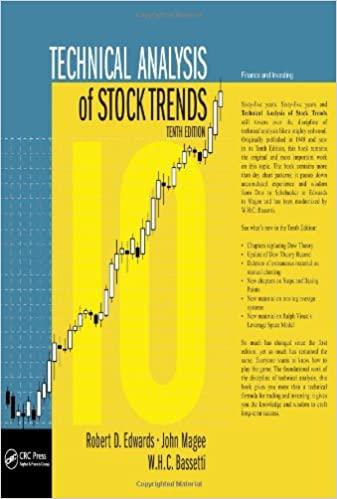Answered step by step
Verified Expert Solution
Question
1 Approved Answer
Suppose you had bought a 3 0 - year Treasury bond at a nominal interest rate of 3 % and the inflation averages 4 %
Suppose you had bought a year Treasury bond at a nominal interest rate of and the inflation averages over the next years. Then
the real interest rate would turn out to be
Hint: Type in the negative sign, if needed.
The quoted or nominal interest rate on a debt security, is composed of a real riskfree rate, plus several premiums that reflect inflation,
the securitys risk, its liquidity or marketability and the years to its maturity:
The quoted interest rate,
where
the quoted, or nominal, rate of interest on a given security;
the interest rate that would exist on a riskless security if no inflation were expected. It may be thought of as the rate of interest
on shortterm US Treasury securities indexed Treasury bonds in an inflationfree world. The real riskfree rate is not staticit
changes over time, depending on economic conditions, especially the rate of return that corporations and other borrowers expect to
earn on productive assets and people's time preferences for current versus future consumption.
inflation premium. is equal to the average expected rate of inflation over the life of the security. The expected future inflation
rate is not necessarily equal to the current inflation rate, so is not necessarily equal to current inflation.
It is the quoted rate on a riskfree security such as a US Treasury bill, which is very liquid and is free of most types of
risk. Note that the premium for expected inflation, is included in
default risk premium. This premium reflects the possibility that the issuer will not pay the promised interest or principal at the
stated time. is zero for US Treasury securities but it rises as the riskiness of the issuer increases.
liquidity or marketability premium. This is a premium charged by lenders to reflect the fact that some securities cannot be
converted to cash on short notice at a "reasonable" price. is very low for Treasury securities and for securities issued by large,
strong firms, but it is relatively high on securities issued by small, privately held firms.
maturity risk premium. Longerterm bonds, including Treasury bonds, are exposed to a significant risk of price declines due to
increases in inflation and interest rates, and a maturity risk premium is charged by lenders to reflect this risk. The prices of longterm
bonds decline whenever interest rates rise, and because interest rates can and do occasionally rise, all longterm bonds, even Treasury
bonds, have an element of risk called interest rate risk. The bonds of any organization have more interest rate risk the longer the
maturity of the bond. Therefore, a maturity risk premium MRP which is higher the greater the years to maturity, is included in the
required interest rate.
For example, if you know that the real rate of interest is and it is expected to remain constant for the next years, inflation is expected to be
next year, the following year, and the third year, then the average expected inflation rate over the next three years is
If also you can estimate that the maturity risk premium is where is number of years to maturity, then
the yield on a year Treasury bill, which has neither default risk premium nor liquidity risk premium, is as follows:
Complete the following table by calculating yields on a and year Treasury bills, respectively.
Yield
year Treasury bill.......
year Treasury bill........
Unlike Treasury securities corporate bonds have both a default risk premium and a liquidity risk premium. Suppose that the liquidity premium on
year bonds is and the default risk premium on year bonds is
The formula for calculating the yield on a corporate bond is

Step by Step Solution
There are 3 Steps involved in it
Step: 1

Get Instant Access to Expert-Tailored Solutions
See step-by-step solutions with expert insights and AI powered tools for academic success
Step: 2

Step: 3

Ace Your Homework with AI
Get the answers you need in no time with our AI-driven, step-by-step assistance
Get Started


